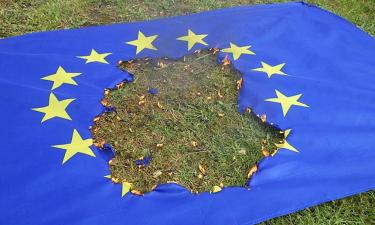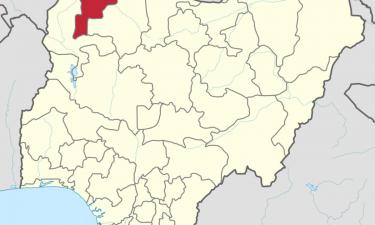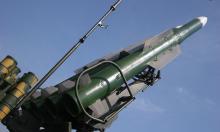May 9, the 57th Victory Day
“People! While your hearts are beating, remember, please, the cost of your happiness!” says the inscription on the Immortality Kurgan in the Readovka park in the Smolensk region.
One-thousand-four-hundred-eighteen long and terrible days passed before the victory in the Second World War. The Soviet people had to go through the awful days thrust on the Soviet Union by international imperialism and German fascism.
June 22, 1941, fascist armadas treacherously and boldly, without declaring a war, came down on the Soviet towns and villages. Tank columns rushed through the borders, sweeping away everything on the way. It was a severe blow. A terrible blow.
Brest Fortress Deed
It is impossible to describe all the days and nights. However, still, I will try to mention some.
I was fifteen when I first heard about deeds of the Brest Fortress defenders. In three years, I saw for myself the old ruins of the fortress, burned and damaged with bombs and shells. My front-line friends and I were shocked when we came to the Brest Fortress. It was impossible to understand how the heroes of the fortress managed to live and fight there. However, people lived and managed to contain the 45th fascist infantry division for almost a month there. Bloody battles were carried out on the small area of the Soviet land. It is scratched on the fortress’ walls “Goodbye Motherland! I die but do not surrender!” The words tell the world about courage and character of Soviet soldiers. It is an unforgettable act.
The heroes of the fortress were short of shells, medicines, water, and food. However, love for the Motherland and hatred for the enemy was abundant. People stood firm till the final breath.
In almost thirty years, being already a military correspondent, I met with the fortress heroes. A memorial complex was opened in Brest. The city looked younger; it was decorated with slogans, flags, and the smiles of people. Even the nature changed the cold weather for lavish warmth and vivid colours. The Indian summer returned in the middle of autumn. The old fortress decorated with sculptures and obelisks was reflected in the waters of the Bug and Mukhovets rivers.
The heroes of the Brest fortress were not so numerous, but they made up one family of 33 nationalities. For every one of them, the Brest Fortress was a symbol of their Motherland, and their duty was to defend it.
I talked to architects Viktor Volchek and Georgy Sysoyev, who were there at the fortress at the memorial opening, to tell about their work. Both were participants of the WWII. “What should we say about our work? The work, as it is, is just what you see with your eyes. We tried to create images of soldiers who knew what the price of the victory was, who were ready to give anything and suffer for a better life of their relatives and families.
Heroes of the Brest Fortress. They are always alive in my memory. Here they are, standing at the ceremony of the memorial opening close to the generals who came from Minsk, Moscow and other parts of the country. They remember perfectly well the days and nights of courage and despair, recollect brother soldiers who gave their lives to defend the Motherland.
The fortress over the Bug river. It was not like Troya, Wearden, and Port Arthur, as they are described by war historians. The Brest Fortress was not protected with one-meter thick stone walls. It was a fortress of human hearts devoted to the Motherland. The hearts that in really hard moments were beating as one large human heart filled with gratitude to the country and pride for its achievements.
2. Even higher than Everest
It was summer. A very hot August smelling of ripen corn, water melons, fish from the Caspian Sea and the Volga river. A well-dressed city was joyous and carefree, it was mirrored in the calm and sun-gilded water of Volga.
Suddenly, I see a green tank turret with a gun looking to the west put on a concrete pedestal. Fifty meters from the bank there is another turret, I see a third one in the open space between the houses. This is how the former front line is marked in the hero city. It is incredible! Volga is at a stone’s throw away, just in front of me. Was the front line here? Were the fascists here, close to the Volga as well? The fascists were at a grenade’s throw from the defenders of the Soviet city of Stalingrad (former name for the Russian city of Volgograd).
I go along the front line and see the place where Valentina Storozhenko, mother of two men members of the people’s volunteer corps, did an unforgettable heroic deed. Fascists seized her at one of the streets and under the threats of shooting demanded her to lead a group of German soldiers dressed in Soviet uniforms to the municipal defence committee.
The woman behaved like a real patriot. She brought the German soldiers to the place their demanded and shouted: “Fascists in disguise follow me! Shoot!” The enemy killed the brave woman, but the fascist group itself was also destroyed. The Stalingrad front line monument is tremendous. It is created so that, in some places it is very close to Volga, in some places it is remote from the river, and sometimes the line even breaks.
After their defeat near Moscow in winter of 1941, the fascists could not resume strategic attacks in several directions, the way they had done at beginning of the war. However, as there was no second front, it was still possible to concentrate forces for a large-scale offensive operation.
Hitler said: “I wanted to reach some definite settlement. It was quite accidental that the city was named after Joseph Stalin.” It was not quite true, as Hitler chose the destination beforehand, as he knew Stalingrad was a key city for the Soviet Union. To occupy Stalingrad and cut the Volga river meant to deprive the Soviet center of oil, manganous ore, cotton, corn, and foodstuffs traditionally supplied from the south of the country. Thus, the objective was really very symbolic for fascists, and the name of the city made the symbolism even stronger. The enemy said that Moscow was Russia’s head and Stalingrad was its heart. The Stalingrad battle was considered by fascists as revenge for their defeat near Moscow. Soviet soldiers and ordinary people also understood perfectly well that the city was of great strategic importance for the whole of the country. People said: “Russia is great, but we have no place to retreat as Moscow is behind us!” This was a slogan for the Stalingrad battle that lasted for 200 days on the banks of Russia’s two greatest rivers. The battle became the biggest one ever seen in the history regarding the number of troops, war strategies, and cruelty of the combat.
Once, I remember, pilots of the Normandy – Neman regiment visited Russia. Stalingrad was practically the only place where the men were eager to go. I accompanied the French pilots to the Volga river, to Stalingrad. It was astonishing that interest of the French pilots to the place was immense. They said: “Stalingrad for the French people is a symbol of firmness and courage in the struggle with fascists.”
Mamayev Kurgan… On war maps it is the height with the mark of 102 meters above the sea. In fact, it is not really very high, but in 1942 the Kurgan was called Russia’s key height. A Soviet poet said, the height was “even higher than all Everests on Earth.”
In memory of Stalingrad heroes a park was founded in the city. In memory of every hero, every soldier who gave their lives in the struggle.
Citizens of Stalingrad remember the day of August 23, 1942. Two thousand flights were performed by fascist planes. Explosions sounded everywhere, buildings collapsed. Hitler issued an order for the Paulus army: Stalingrad was to be occupied on August 25. Fascists were sure of an immediate triumph, but they hardly realised what would be resistance of the Soviet army. The Paulus army was destroyed. The defeat became a real surprise for Germans. I wonder if you, dear readers, know anything about the Tarawa battle? And about battles near the Isle of Guadalcanal? Nowadays the battles are considered in the West as more cruel than the Stalingrad battle.
Let us be honest: everyone has got the right to be proud with what one chooses. But calculations reveal quite a different situation. Fascists made up 81 divisions in the Stalingrad battle, they lost 1,5 million soldiers and officers in the battle. As for the battles near Guadalcanal and Tarawa, the forces were represented the following way: 80,000 of American soldiers vs. 20,000 Japanese and 15,000 Americans vs. 4,000 Japanese, respectively. Americans lost 913 people in those cruel battles.
3. Overlord operation
We held out against fascism practically face-to-face, as the allies did not provide a second front as they had promised on June 12, 1942. At the time when the Soviet army shed blood in Stalingrad, in the Caucasus and in the Novgorod region, the only thing we got from our allies was only promises. No second front was also opened in 1943, 1944. And finally, when results of the war could be already predicted, when it came to liberation of Europe from fascist occupants, the allies started the Overlord Operation that provided for forced crossing of the English Channel and landing in Normandy.
Soviet General Nikolay Lyaschenko, who was commander of a regiment and further of a division in the WWII, told me about those days. “As for Overlord. The front line made up over 4,000 kilometres in that summer – autumn campaign. Allies in the west were on the front line of 600 kilometres and in the south of Italy the line made up 300 kilometres. We passed up to 1,200 kilometres in some directions. The allies advanced 260-400 kilometres ahead. In November the advance stopped, and some time later the allies battled severely with fascists in Ardennes.
Churchill addressed Stalin with a request to facilitate the east front offensive to rescue the allies. On January 12, 1945 Soviet army started moving ahead on the territory from the Baltic Sea to the Carpathian Mountains. It was a really difficult offensive. The weather was nasty.” 4. Nobody is forgotten
It is a right slogan, but unfortunately, it does not always agree with the reality. Even in our days groups of young people organise searches for remains of WWII heroes that were not committed to earth. And not all common graves are in good condition and need repair, no matter where they are situated, in large cities in the centre of Russia or in small villages. We already marked so many anniversaries of the Victory Day, but there are still soldiers who are not committed to earth.
It is traditionally said in Russia, practically every family lost its members in the WWII. It means, the war brought woe in every Soviet family. But against the background of the whole nation pain and woe of one person seems not so great. The nation held out against the enemy and won the war. It was a really hard and great victory. People are extremely proud of the victory. But at the same time the hearts of Russian people are filled with pain and sorrow, they are immense and will always be with us, in our hearts. What is more painful, is that we failed to keep results brought by the Great Victory. The Soviet Union, the family of socialistic countries broke-up. Russia lost seas and lands that had been joined into one great state by our ancestors with such great efforts and losses. And we should be ashamed that within some dozen of years Russia turned from a really powerful state into a third-rate beggar entrapped into an economic servitude. It is a shame.
Vasily Izgarshev Colonel in the Second World War Honoured worker of RF culture (Newspaper PRAVDA June 22, 1999)
Translated by Maria Gousseva
Read the original in Russian: https://www.pravda.ru/main/2002/05/08/40825.html
Subscribe to Pravda.Ru Telegram channel, Facebook, RSS!




